Glaciers
- A glacier is a huge mass of ice that moves slowly over land. The term “glacier” comes from the French word glace (glah-SAY), which means ice. Glaciers are often called “rivers of ice.”
- Glaciers normally assume the shape of a tongue, broadest at the source & becoming narrower downhill.
- Though glacier is not liquid, but it moves gradually under the continual pressure from the snow accumulated above.
- The rate of movement is greatest in the middle where there is little obstruction.
- The sides & bottom are held back by the frictions due to valley sides & valley floors.
- If a row of stakes is planted across a glacier in a straight line, they will eventually take a curved shape down the valley, showing that the glacier moves faster at the center than at the sides.
- Glacial Landforms can be found in locations that currently have no active glaciers or glaciation processes.
- Glaciers fall into two groups: alpine glaciers and ice sheets
- Alpine glaciers
- Alpine glaciers form on mountainsides and move downward through valleys.
- Sometimes, alpine glaciers create or deepen valleys by pushing dirt, soil, and other materials out of their way.
- Alpine glaciers are found in high mountains of every continent except Australia (although there are many in New Zealand).
- The Gorner Glacier in Switzerland and the Furtwangler Glacier in Tanzania are both typical alpine glaciers.
- Alpine glaciers are also called valley glaciers or mountain glaciers.
- Ice sheets
- Ice sheets, unlike alpine glaciers, are not limited to mountainous areas. They form broad domes and spread out from their centers in all directions.
- As ice sheets spread, they cover everything around them with a thick blanket of ice, including valleys, plains, and even entire mountains.
- The largest ice sheets, called continental glaciers, spread over vast areas. Today, continental glaciers cover most of Antarctica and the island of Greenland.
- Massive ice sheets covered much of North America and Europe during the Pleistocene time period. This was the last glacial period, also known as the Ice Age. Ice sheets reached their greatest size about 18,000 years ago. As the ancient glaciers spread, they carved and changed the Earth’s surface, creating many of the landscapes that exist today.
- During the Pleistocene Ice Age, nearly one-third of the Earth’s land was covered by glaciers. Today, about one-tenth of the Earth’s land is covered by glacial ice.
- Read here: Types of Glaciers
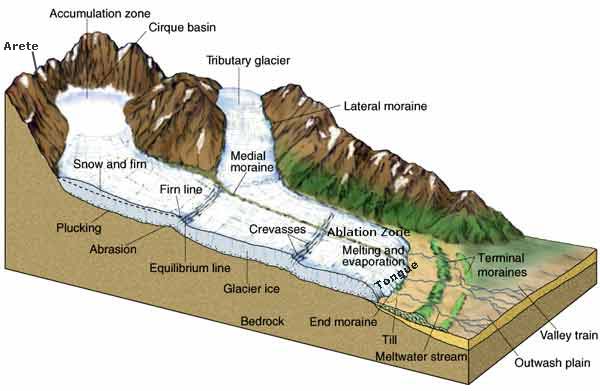
The Ice-Age and Ice masses
- An ice age is a long period of reduction in the temperature of Earth’s surface and atmosphere, resulting in the presence or expansion of continental and polar ice sheets and alpine glaciers.
- Earth’s climate alternates between ice ages and greenhouse periods, during which there are no glaciers on the planet.
- Earth is currently in the Quaternary glaciation.
- Today, only 2 major ice caps are present in this world – Antarctica & Greenland, along with many highlands above the snowline surviving in the world.
- Ice from the ice cap creeps out in all directions to escape as glaciers.
- When the ice sheets reaches down to the sea they float as ice shelves in polar waters.
- When ice sheets break into individual blocks, these are called icebergs.
- While afloat in the sea, only 1/9th of the iceberg’s mass is visible above the surface.
- They diminish in size when reaching warm waters & eventually melted, dropping the rock debris that was frozen inside them on the sea bed.
- Permanent snowfield is sustained by heavy snowfall in winters & ineffective snow melting & evaporation in summers as part of snow that melt during the day is refrozen during the night.
- This refreezing process repeats until it forms a hard, granular substance known as neve or firn.
- Owing to the gravitational forces, neve of the upland snowfield is drawn towards the valley below, which marks the beginning of the flow of glacier (river of ice).
Glacial Cycle of Erosion
- Youth:
- The stage is marked by the inward cutting activity of ice in a cirque. Aretes and horns are emerging. The hanging valleys are not prominent at this stage.
- Maturity:
- The valley glacier gets transformed into a trunk glacier and hanging valleys start emerging. The opposite cirques come closer and the glacial trough acquires a stepped profile that is regular and graded.
- Old Age:
- The emergence of a ‘U’-shaped valley marks the beginning of old age. An outwash plain with features such as eskers, kame terraces, drumlins, kettle holes, etc. is a prominent development. The opposite cirques coalesce and the summit heights are greatly reduced. Mountain tops become rounded.
Glacial Landforms
- Glaciations generally gives rise to erosional features in the highlands & depositional features on lowlands
- It erodes its valley by two processes viz. plucking & abrasion.
- Plucking: Glacier freezes the joints & beds of underlying rocks, tears out individual blocks & drags them away.
- Abrasion: Glacier scratches, scrapes, polishes & scours the valley floor with the debris frozen into it.
Glacial Landforms – Erosional
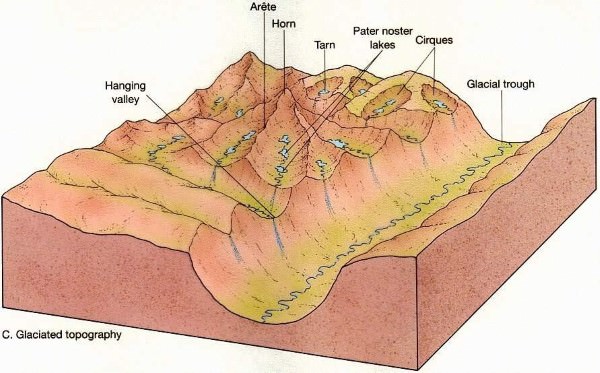
Snout or Glacier terminus
- A glacier terminus, toe, or snout, is the end of a glacier at any given point in time.
- The terminus is the usually the lowest end of glacier.
Corrie, Cirque or cwm
- The downslope movement of a glacier from its snow-covered valley head & the the intensive shattering of the upland slopes, tend to produce a depression where neve or firn accumulates.
- Plucking & abrasion further deepen the depression into a steep horse shoe-shaped basin called Cirque (in French), cwm (in wales) & Corrie (in Scotland)
- There is a rocky ridge at the exit of the corrie & when the ice eventually melts, water collect behind this barrier known as Corrie Lake or tarn.
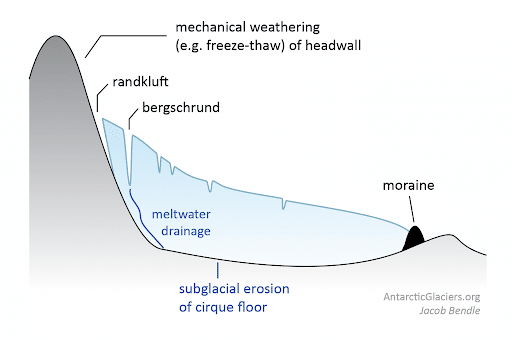
Cols
- Cols form when two cirque basins on opposite sides of the mountain erode the arête dividing them.
- Cols create saddles or passes over the mountain.
Horns
- Horns are a single pyramidal peak formed when the summit is eroded by cirque basins on all sides.
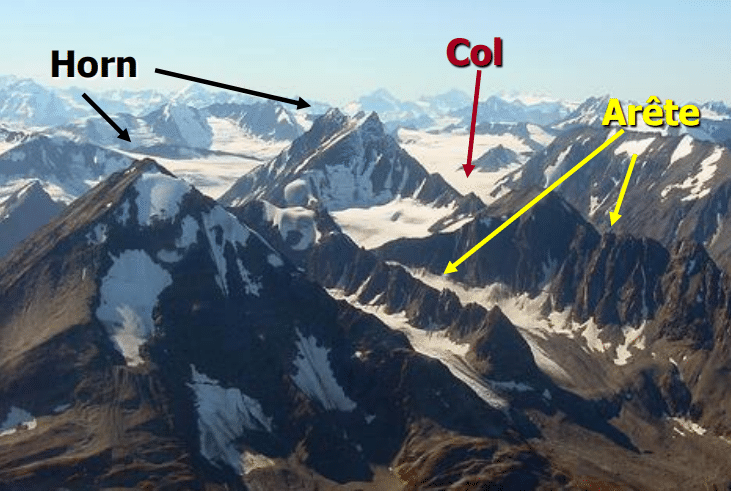
Aretes and Pyramidal Peaks
- When two corries cut back on opposite sides of the mountain, knife edged ridges are formed called arêtes
- When three or more cirques cut back together, recession will form an angular horn or pyramidal peak.
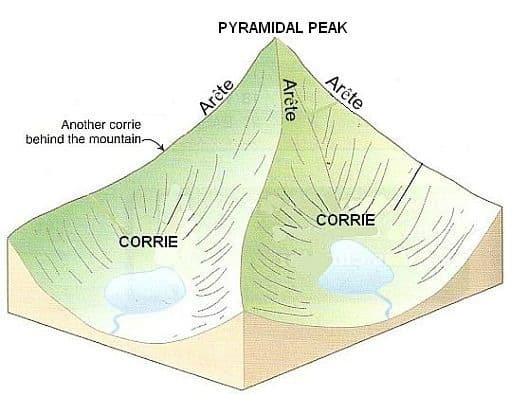
Bergschrund
- At the head of a glacier, where it begins to leave the snowfield of a corrie, a deep vertical crack opens up called a Bergschrund or Rimaye
- This happens in summer when although the ice continues to move out of the corrie, there is no new snow to replace it
- In some cases, not one but several such cracks occur which present a major obstacle to climbers
- Further down, where the glacier negotiates a bend or a precipitous slope, more crevasses or cracks are formed.

Roche moutonnée
- Basically, a resistant residual rock hummock or mound, striated by the ice movement.
- Its upstream or stoss side is smoothened by abrasion & its downward or leeward side is roughened by plucking & is much steeper.
- It is believed that plucking may have occurred on the leeward side due to a reduction in pressure of the glacier moving over the stoss slope
- Therefore providing the opportunity for water to refreeze on the lee side and pluck the rock away.
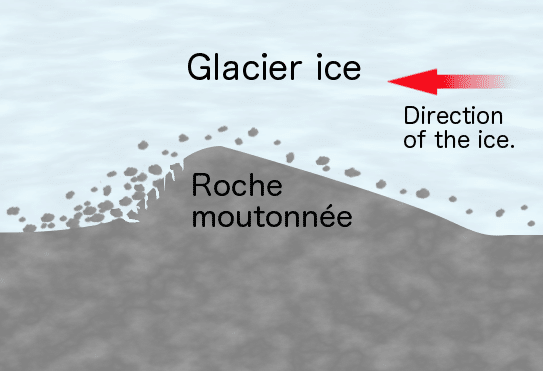
Crag and tail
- A crag and tail is a larger rock mass than a Roche moutonnee
- Like a Roche moutonnee, it is formed from a section of rock that was more resistant than its surroundings.
- Crag is a mass of hard rock with a steep slope on the upward side, which protects the softer leeward slope from being completely worn down by the oncoming ice.
- It therefore has a gentle tail strewn with the eroded rock debris.
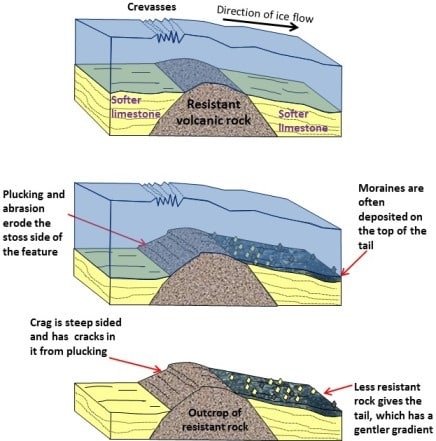
Nunatak
- A nunatak is the summit or ridge of a mountain that protrudes from an ice field or glacier that otherwise covers most of the mountain or ridge. They are also called glacial islands.
- Nunatak is a mountain peak or other rock formation that is exposed above a glacier or ice sheet.
Paternoster Lakes
- A paternoster lake is one of a series of glacial lakes connected by a single stream or a braided stream system.
- Paternoster lakes are formed in the low depression of a U-shaped valley.
- Paternoster lakes are created by recessional moraines, or rock dams, that are formed by the advance and subsequent upstream retreat and melting of the ice.
U shaped glacial Troughs & Ribbon lakes
- Glaciers on their downward journey are fed by several corries scratches & grind the bedrock with straightening out any protruding spurs.
- The interlocking spurs are thus blunted to form truncated spurs with the floor of the valley deepened.
- Hence, the valley which has been glaciated takes the characteristic of U shape, with a wide flat floor & very steep sides.
- After the disappearance of the ice, the deep sections, of these long, narrow glacial troughs may be filled with water forming Ribbon lakes also known as Trough lakes or Finger Lakes.
Hanging Valleys
- The main valley is eroded much more than the tributary valley as it contains a much larger glacier.
- After the ice has been melted, a tributary valley hangs above the main valley & plunges down as a waterfall. Such Tributary valleys are termed as hanging valleys.
- Hanging valleys may form a natural head of water for generating hydroelectric power.
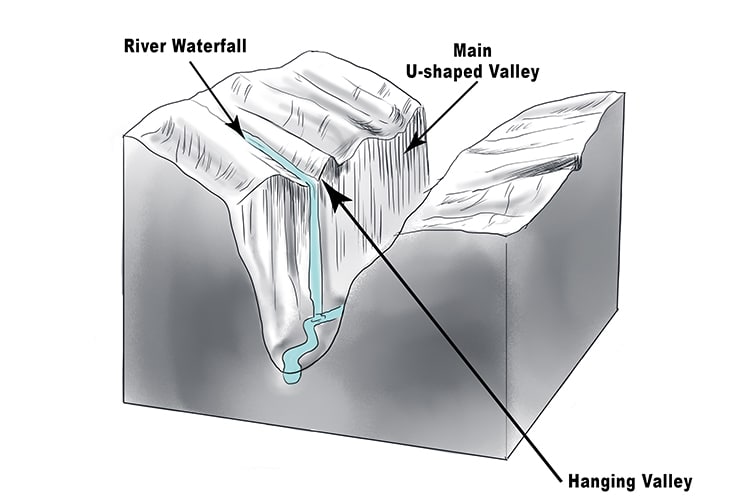
Rock Basins and Rock Steps
- A glacier erodes & excavates the bed rock in an irregular manner.
- The unequal excavation gives rise to many rock basins later filled by lakes in valley trough.
- Where a tributary valley joins a main valley, the additional weight of ice in the main valley cuts deeper into the valley floor & deepest at the point of convergence forming rock steps.
- A series of such rock steps may also be formed due to different degrees of resistance to glacial erosion of the bedrocks.
Fjord
- If the glacier flows right down to the sea, it drops its load of moraine in the sea.
- If sections break off as icebergs, moraine material will only be dropped when they melt
- Where the lower end of the trough is drowned by the sea, it forms a deep, steep side inlet called a Fjord, a typical of Norway & Chilean coast.
- Fjords are common in Norway, Greenland and New Zealand.

Glacial Landforms – Depositional

Boulder clay or Glacial till
- This is an unsorted glacial deposit comprising a range of eroded materials such as boulders, sticky clays & fine rock flour.
- It is spread out in sheets, not mounds, & forms gently undulating till or drift plains with monotonous landform.
- The degree of fertility of such glacial plains depends very much on the composition of the depositional materials.
Erratics
- Boulders of varying sizes are transported by ice & left stranded in the regions of deposition when the ice melted, called erratics because they are composed of materials entirely different from those of the regions in which they have been transported.
- Useful in tracing the source & direction of ice movements but their presence in large numbers causes hindrance in farming.
- Also known as perched blocks as sometimes they are found perched in precarious positions as the ice dropped them.
Moraines
- Moraines are made up of pieces of rock that are shattered by frost action, embedded in the glaciers & brought down the valley.
- Those that fall on the sides of the glacier form lateral moraines.
- When two glaciers converge, their inside lateral moraines unite to form a medial moraine.
- The rock fragments which are dragged along, beneath the frozen ice, are dropped when the glacier melts & spread across the floor of the valley as ground moraine.
- The glacier eventually melts on reaching the foot of the valley & the pile of transported materials left behind at the snout is terminal moraine or end moraine.
- The deposition of end moraines may be in several succeeding waves, as the ice may melt back by stages so that a series of recessional moraines are formed.
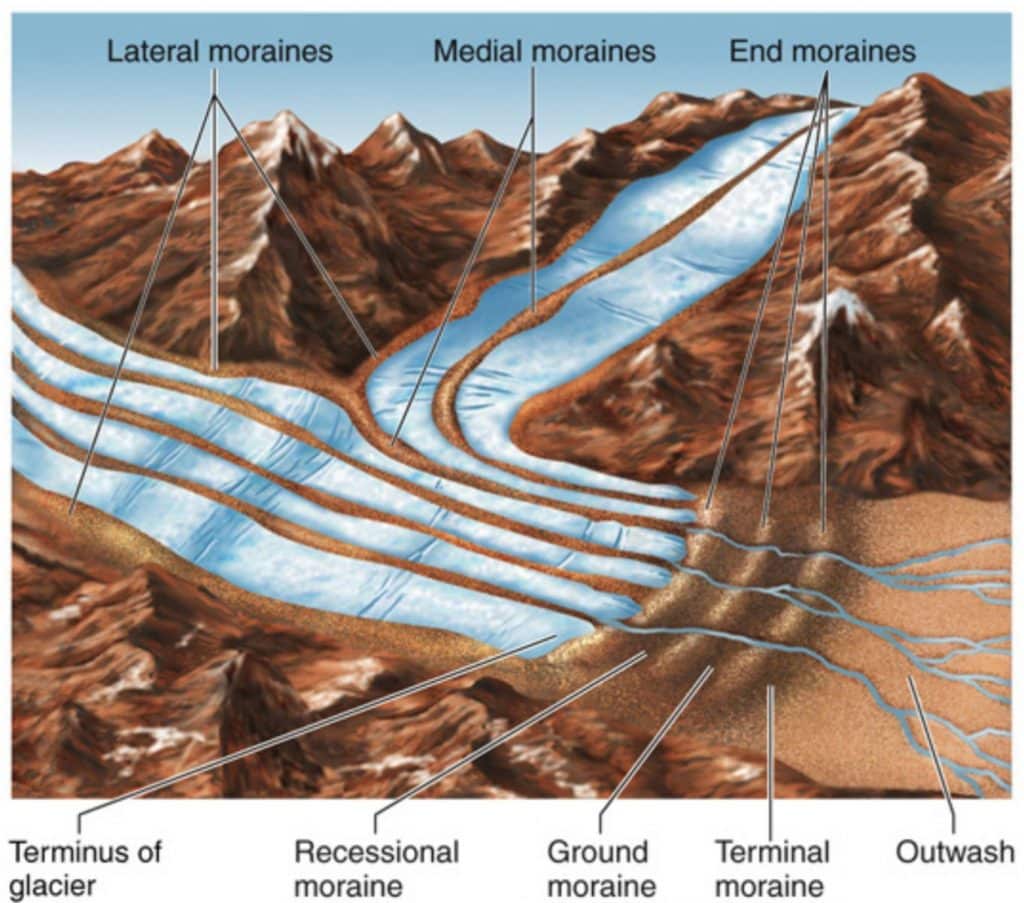
Drumlins
- Drumlins are oval-shaped hills, largely composed of glacial drift, formed beneath a glacier or ice sheet and aligned in the direction of ice flow.
- They are widespread in formerly glaciated areas and are especially numerous in Canada, Ireland, Sweden, and Finland.
- They are low hills up to 1.5 km long and 60 mm tall & appear steeper on the onset side & taper off at the leeward side.
- They are arranged diagonally & commonly referred as a basket of eggs topography.
- ′Basket of egg topography′ is the topography of drumlins, which are generally found in clusters.
- Drumlin fields are areas with numerous drumlins.
Eskers
- Eskers are the sinuous ridges composed of glacial material mainly sands & gravel deposited by meltwater currents in glacial tunnels
- Glacial tunnels mark the former sites of sub glacial melt water streams
- Their orientation is generally parallel to the direction of glacial flow, and they sometimes exceed 100 kilometers in length.
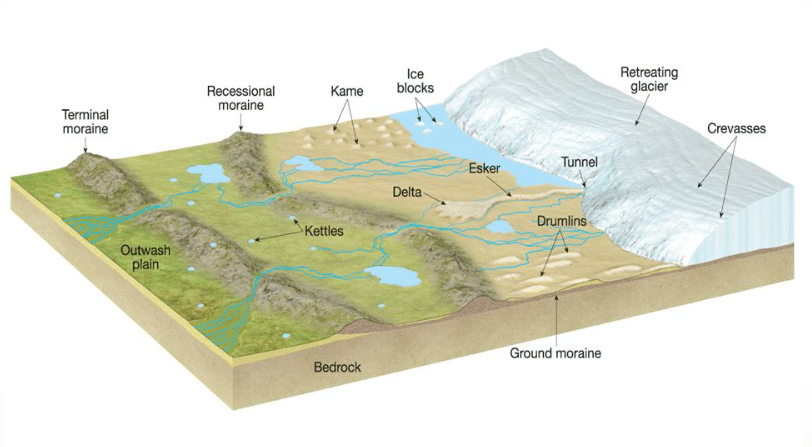
Outwash Plains
- Made up of fluvio glacial deposits washed out from the terminal moraines by the streams of stagnant ice mass.
- The melt waters sort & redeposit the material mainly consisted of layers of sand and other fine sediments.
- Such plains with their sandy soils are often used for specialized kinds of agriculture, such as the potato.
Kettle lake
- Depressions are formed when the deposition takes place in the form of alternating ridges.
- Shallow, sediment-filled bodies of water formed by retreating glaciers.
Kames
- Small rounded hillocks of sand & gravel which cover part of the plain.
- Kames are often associated with kettles, and this is referred to as kame & kettle topography.
- Kame is also called Hummocks.
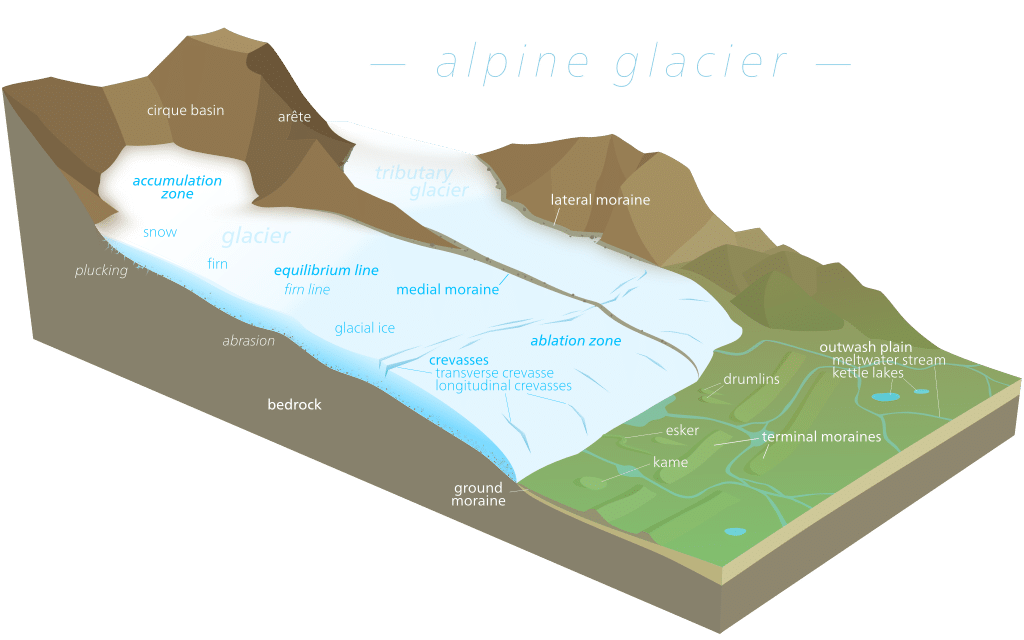

Is this notes for optional or mains and prelims
these are too extensive so they are for optional, but you can refer them for GS as well
‘Fjords’ and ‘Purvaiyya’ have diluted this boundary between Optional and GS